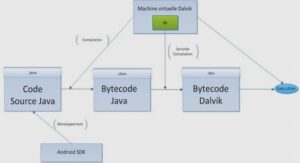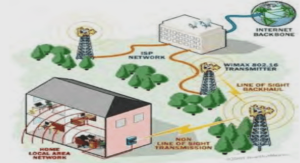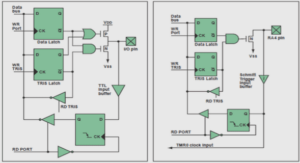Development of 1 kHz, few-cycle, mJ level CEP stabilized laser source
CEP stabilized oscillator
The oscillator is a Kerr lens mode locking Rainbow CEP type (femtolasers GmbH) [1]. It delivers pulses with an energy of 2.5 nJ at a repetition of 80 MHz. The schematic of the cavity is presented in Fig. 6.1. The spectrum emitted by the oscillator is shown in Fig. 6.2. The FWHM is 220 nm corresponding to a transform limited duration of 6.8 fs. A nonlinear interferometer is implemented after the oscillator for the stabilization of the CEP with a fast loop. The pulses are focused with a concave mirror in a PPLN (Periodically Poled Lithium Niobate) crystal. The intensity in the crystal is high enough to broaden the spectrum by SPM and to generate intrapulse difference frequency generation (DFG) between the high frequency and low frequency part of the spectrum [2]. Interference between lower frequencies of the fundamental spectrum and the difference frequency signal yields a beating at the frequency fceo. This signal is directed with a dichroic mirror to a frequency meter and a feedback electronic loop for the stabilization of the CEP (section 2.2.1). When the feedback loop is activated the electronic part of the stabilizing system controls an acousto-optic modulator that modulates the pump power of the oscillator. The resulting variation in intensity of the pulse inside the cavity forces fceo to be equal to frep/4. Forcing the two signals to oscillate in phase gives ∆ϕ0 = 2π/4, so that every 4 pulses exiting the cavity have identical CEP ϕ0. For the correct operation of the system the frequency fceo must be detected with a signal to noise ratio (SNR) higher than 30 dB.The oscillator pulses then go through an optical isolator and are stretched in a 20 cm block of glass (SF7).
Multi-pass amplifier
The commercial multi-pass amplifier (10 passes) delivers pulses with an energy of 2 mJ at 1 kHz (Fig. 6.4). The pump laser is a Nd:YLF (PI, Photonics Industries) delivering 1 kHz, 50 mJ (50 W) pulses at 527 nm. Only 11 W are used for pumping this amplification stage. In the first 8 passes the energy goes from few nJ to 400 µJ. After the fourth pass the beam goes through the AOPDF (HR800) and a Pockels cell for the selection of a train of pulses at 1 kHz. These pulses are further amplified to an energy of 2 mJ. The ASE level estimated by blocking the injection in the amplifier is around 40 µJ. The choice of the location of the AOPDF in the amplifier is original. We chose this configuration because, due to the gain narrowing in the first 4 passes, the spectral bandwidth injected into the the AOPDF is reduced compared to the case where it is placed after the oscillator. As a consequence, the diffraction efficiency of the AOPDF is higher, and thus the pulses can be amplified to the mJ level in the following passes while maintaining a good temporal contrast (108 at the output of the Femtopower).
AOPDF (Dazzler) During all my Ph.D
I used several times the AOPDF [3] for the pulse shaping and characterization. I give here a brief introduction of this device. It is constituted of a T eO2 crystal which is optically and acoustically birefringent. An acoustic wave is launched by a transducer excited by an electronic signal. The acoustic wave propagates with a velocity V along the z axis and hence reproduces spatially the temporal shape of the rf signal. Two optical polarization modes can be coupled efficiently by the acousto-optic interaction only when some phase matching condition is achieved. If there is locally only one spatial frequency in the acoustic grating, then only one optical frequency can be diffracted at a position along z. The incident optical short pulse is initially in mode 1. Every frequency ω travels a certain distance before it encounters a phase-matched spatial frequency of the acoustic wave. At this position z(ω), part of the energy is diffracted into mode 2. The pulse leaving the device in mode 2 will be made up of all the spectral components that have been diffracted at various positions z(ω). Since the velocities of the modes are different, each frequency will experience a different time delay. The amplitude of the output pulse, or diffraction efficiency, is controlled by the acoustic power at position z(ω). The optical output Eout(t) of the AOPDF is a function of the optical input Ein(t) and of the electric signal H(t). More precisely, it has been shown to be proportional to the convolution of the optical input and the scaled electric field: Eout(t) ∝ Ein(t) ⊗ H(t/α) (6.1) 117 where the scaling factor, α = ∆n(V/c), is the ratio of the speed of sound to the speed of light times the index difference between the ordinary and extraordinary polarizations. α is the ratio of the acoustic frequency. Relation (6.1) can be written in the frequency domain as: E˜ out(ω) ∝ E˜ in(ω)H(αω) (6.2) In this formulation H(t/α) appears as the impulse response of a filter applied to the input optical pulse. By generating a proper function S(t) one can achieve any arbitrary convolution with a temporal resolution given by the inverse of the available filter bandwidth.
Home made amplifier
The second amplifier is a home made three-pass amplifier. A schematic of this amplifier is shown in Fig. 6.6. The Ti:Sa crystal, cut at Brewster angle, is under vacuum and cooled at 195 K. The pump beam is down collimated by a (3:1) telescope and is then focused with a lens (L2) on the crystal. The power of the pump is 25 W. The absorbtion of the crystal is 75 % and the transmitted beam is refocused with a concave mirror (M1). The injection beam passes through an optical isolator to avoid any return into the first amplifier. A mirror telescope and a focusing lens (L1) are used to achieve the correct beam size on the crystal. After each pass the beam is re-imaged using concave dielectric mirrors (M2-M3) in order to have for each pass the correct beam size on the crystal. The diameter at 1/e2 in intensity of the infrared beam is roughly 1 mm for each pass. The geometrical focus for each pass is located before the crystal to have a slightly divergent beam to compensate the thermal lens in the crystal. The beam focus is inside the vacuum chamber to avoid any nonlinear effects in air. The output energy is 6 mJ. The total gain of the amplifier is 7.5.
The number of passes in this amplifier is limited to three due to the high B integral value (1.35 rad). This value needs to be added to the 3.5 radians already accumulated in the first amplifier. A total B integral higher than 4 radians is typically considered too high for the correct functioning of a CPA laser. As shown in the next section, the DazScope technique enables to measure and pre-compensate this nonlinear phase and therefore to achieve near perfectly compressed pulses. The high B integral of this chain originates from the small pulse stretching (10 ps). This choice is motivated by the fact that a small stretching factor enables the use of prism or very compact gratings compressors with increased insensitivity to dispersion fluctuations. This is of fundamental importance for achieving a good CEP stability.
Hybrid compressor: prism + chirped mirrors
The calculations for the design of the prism compressor were made by A. Trisorio from the PCO group. The values of dispersion added by this compressor are shown in Tab.1 together with the overall dispersion of the laser system Tab.2. The picture of the prisms and a schematic of the prism compressor are shown in Fig. 6.9 and Fig. 6.10 To limit SPM in the last prism, the temporal compression is ended by 32 reflections on two negatively dispersive chirped mirrors (Fig. 6.11). The characteristics of these chirped mirrors are: • reflectivity higher than 99.5 % for a spectral range between 760 and 840 nm • a damage threshold of 400 mJ/cm2 121 • a second order dispersion of -200 fs2 per bound with an angle of incidence of 15° The pulse duration after the prism compressor is roughly 1 ps and is reduced to 22 fs after the 32 reflections (The total dispersion introduced by the chirped mirrors is -6400 fs2 ).




